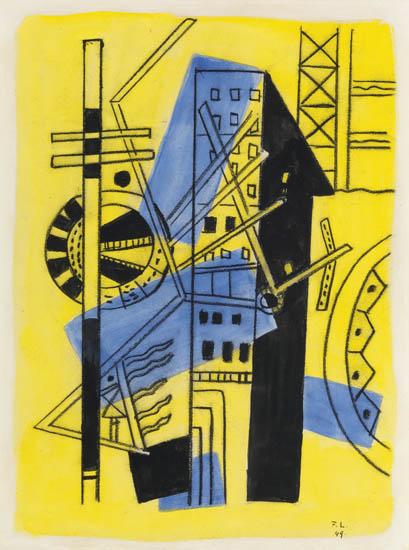Sale 2322 - Lot 460
Price Realized: $ 40,000
Price Realized: $ 50,000
?Final Price Realized includes Buyer’s Premium added to Hammer Price
Estimate: $ 30,000 - $ 50,000
FERNAND LÉGER
Villes I.
Gouache and watercolor and charcoal on paper, 1949. 330x245 mm; 13x9 5/8 inches. Initialed and dated in ink, lower right recto. Inscribed, 'gouache originale de Fernand Léger pour Les Illuminations de Rimbaud... lui-même l'editeur" and annotated in pencil, verso. With the Louis Grosclaude, Éditeur, ink stamp, verso.
Ex-collection Mr. and Mrs. Lester Francis Avnet, with the original label.
A gouache created during the production of Les Illuminations, 1949 (see Saphire 34). Mr. Saphire writes, "Many gouaches on themes found in Les Illuminations were done during and after the work on the book."
Léger (1881-1955) was a prominent French artist who first made his mark as a Cubist painter before developing his own distinctive graphic style that was arguably a forerunner to Pop Art. Born in Normandy and initially trained as an architect, Léger mover to Paris in 1900 to work in an architectural firm before he was drafted into the army from 1902-03. When he returned from his military service he began to study painting at the School of Decorative Arts (after he was rejected from École des Beaux-Arts) and spent three unremarkable years studying from Academic artists and painting in the Impressionist style (most of the paintings from this period he later destroyed). He became truly inspired to develop his own style when he viewed a retrospective of Cézanne--which prompted him to incorporate geometric planes into his works.
In 1909, Léger moved to Montparnasse and fraternized with other avant-garde artists, including Archipenko and Chagall, all the while further developing his unique form of Cubism (which critics called "Tubism") that incorporated abstract cylindrical, conical and curvilinear shapes. His specific approach to Cubist image making earned him recognition as one of the forerunners of Cubism and from 1911 to 1914 he was included in historic Cubist exhibitions of the Salon d'Automne and Salon des Indépendants with Jean Metzinger, Robert Delaunay, the Duchamp brothers, Henri Le Fauconnier, Albert Gleizes and Francis Picabia (which was called the Puteaux Group).
At the onset of World War I in 1914, Léger was drafted into the military, an experience which had a profound impact on his work. In 1916, he endured a near fatal mustard gas attack and, while in convalescence, Léger's work continued to shift away from abstract "Tubism" toward the figurative, sleek forms of his "mechanical period." After the war he began to formalize his style, depicting renditions of archetypal subjects like the Madonna and Child, the female nude, Adam and Eve, and began using motifs and details from modern life in canonical subjects (showing Adam from Adam and Eve, 1935, Musée National Fernand Léger, in swim trunks and tattooed, for example). During this period, he also began incorporating cinematic perspectives (he actually considered abandoning painting to pursue filmmaking) and used promotional advertisements as inspiration for compositions. All the while his work became more flat, graphic and monumental. Léger continued to develop his distinctive personal style through the 1920s and 1930s, receiving recognition throughout Europe and America.
In 1940, with the outbreak of World War II, Léger relocated to the United States where he taught at Yale University and produced paintings that found their inspiration in the contrast between abandoned machinery and the landscape--imagery present in this gouache.
After returning to France in 1945, he joined the Communist Party and produced more works utilizing populist subjects of bathers, acrobats, and clowns--works depicting common man for the visual consumption of the common man. Tirelessly creative, he worked on a variety of illustrated books, sculptures, ceramic, mosaics and theatrical set designs. The current gouache coincides with this final period in Léger's career and is an original design for the lithograph with pochoir coloring in Les Illuminations, with text by Arthur Rimbaud (Saphire 34). Léger created numerous variations of the same themes for the 15 prints illustrating Les Illuminations before determining the final compositions. According to correspondence between Léger and the editor of Les Illuminations, M. Louis Grosclaude, there were a number of difficulties in printing Villes I as an acceptable pochior--the main problem was that when the blue was added over the black outlines it obscured them and ruined the intended quality of the image.
Villes I.
Gouache and watercolor and charcoal on paper, 1949. 330x245 mm; 13x9 5/8 inches. Initialed and dated in ink, lower right recto. Inscribed, 'gouache originale de Fernand Léger pour Les Illuminations de Rimbaud... lui-même l'editeur" and annotated in pencil, verso. With the Louis Grosclaude, Éditeur, ink stamp, verso.
Ex-collection Mr. and Mrs. Lester Francis Avnet, with the original label.
A gouache created during the production of Les Illuminations, 1949 (see Saphire 34). Mr. Saphire writes, "Many gouaches on themes found in Les Illuminations were done during and after the work on the book."
Léger (1881-1955) was a prominent French artist who first made his mark as a Cubist painter before developing his own distinctive graphic style that was arguably a forerunner to Pop Art. Born in Normandy and initially trained as an architect, Léger mover to Paris in 1900 to work in an architectural firm before he was drafted into the army from 1902-03. When he returned from his military service he began to study painting at the School of Decorative Arts (after he was rejected from École des Beaux-Arts) and spent three unremarkable years studying from Academic artists and painting in the Impressionist style (most of the paintings from this period he later destroyed). He became truly inspired to develop his own style when he viewed a retrospective of Cézanne--which prompted him to incorporate geometric planes into his works.
In 1909, Léger moved to Montparnasse and fraternized with other avant-garde artists, including Archipenko and Chagall, all the while further developing his unique form of Cubism (which critics called "Tubism") that incorporated abstract cylindrical, conical and curvilinear shapes. His specific approach to Cubist image making earned him recognition as one of the forerunners of Cubism and from 1911 to 1914 he was included in historic Cubist exhibitions of the Salon d'Automne and Salon des Indépendants with Jean Metzinger, Robert Delaunay, the Duchamp brothers, Henri Le Fauconnier, Albert Gleizes and Francis Picabia (which was called the Puteaux Group).
At the onset of World War I in 1914, Léger was drafted into the military, an experience which had a profound impact on his work. In 1916, he endured a near fatal mustard gas attack and, while in convalescence, Léger's work continued to shift away from abstract "Tubism" toward the figurative, sleek forms of his "mechanical period." After the war he began to formalize his style, depicting renditions of archetypal subjects like the Madonna and Child, the female nude, Adam and Eve, and began using motifs and details from modern life in canonical subjects (showing Adam from Adam and Eve, 1935, Musée National Fernand Léger, in swim trunks and tattooed, for example). During this period, he also began incorporating cinematic perspectives (he actually considered abandoning painting to pursue filmmaking) and used promotional advertisements as inspiration for compositions. All the while his work became more flat, graphic and monumental. Léger continued to develop his distinctive personal style through the 1920s and 1930s, receiving recognition throughout Europe and America.
In 1940, with the outbreak of World War II, Léger relocated to the United States where he taught at Yale University and produced paintings that found their inspiration in the contrast between abandoned machinery and the landscape--imagery present in this gouache.
After returning to France in 1945, he joined the Communist Party and produced more works utilizing populist subjects of bathers, acrobats, and clowns--works depicting common man for the visual consumption of the common man. Tirelessly creative, he worked on a variety of illustrated books, sculptures, ceramic, mosaics and theatrical set designs. The current gouache coincides with this final period in Léger's career and is an original design for the lithograph with pochoir coloring in Les Illuminations, with text by Arthur Rimbaud (Saphire 34). Léger created numerous variations of the same themes for the 15 prints illustrating Les Illuminations before determining the final compositions. According to correspondence between Léger and the editor of Les Illuminations, M. Louis Grosclaude, there were a number of difficulties in printing Villes I as an acceptable pochior--the main problem was that when the blue was added over the black outlines it obscured them and ruined the intended quality of the image.

Exhibition Hours
Exhibition Hours
Aliquam vulputate ornare congue. Vestibulum maximus, libero in placerat faucibus, risus nisl molestie massa, ut maximus metus lectus vel lorem.


